Working with tiles requires at least minimal knowledge from the repairman. It is impossible to foresee all the nuances of laying tiles. However, there is a list of standard tips that you should listen to in order to prevent the material from deforming and ruining the repair. In the article, we will consider: with which drill to drill tiles, tools for work and analyze how best to make a hole of large diameter.
Features of tile and work with it
The main feature of an artificial stone, a tile, consists in the high level of hardness and durability. Some types of ceramic products are almost impossible. Repairers often fail to drill porcelain stoneware for the following reasons: incorrectly selected drills, too high drill speeds.
Characteristics of the tile:
- high silicon content in the composition, due to which the material is very hard;
- tiles can be heat treated at high temperatures, as a result, high-strength artificial stone is used in repairs;
- in the manufacture of porcelain stoneware slabs, ordinary clay is used, which is covered with a layer of silicon. When you figure out how to drill a tile into a wall, you can analyze that the hard surface is followed by the more walkable part of the ceramic piece.
How to drill a tile: preparation for work
The technology of drilling tiles has its own characteristics. Drilling equipment is used only when a hole of small diameter is formed. Beforehand, it is worth checking the plate for the possibility of drilling and the absence of voids. To do this, lightly tap on it, if the sound is deaf, feel free to proceed to the choice of a drill. This is necessary to prevent cracking and damage to the tiles.
To create a hole of the desired diameter, select special drills made of high-quality carbide. It is best to use spear-shaped parts. There are no restrictions on the choice of a drill: you can use both electric and manual ones. It is not recommended to take high-grade tools, because of their very fast rotation, you can ruin the tile. 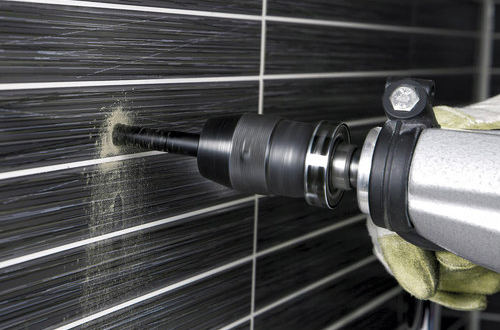
tile drilling process
To get started, you need to designate the centers of the holes in which you will drill. This can be done with an ordinary tile marker or pencil. Further, you will encounter the problem of the drill slipping from a chosen point. In order to get to the center and make the right hole you need:
- Take a drill and make a small indentation for which you can catch on. This will be a niche for adjusting the center of the hole. Install a drill bit in place of the intended drilling and proceed to full-fledged work with tiles;
- Additionally, to adjust the center of drilling, use the jig. Depending on the selected drill, determine the type of hole. Press the jig in the right place and drill the tile through the plate;
- To facilitate this process, a mounting tape is used. Special strips fix the drill, which is clearly directed from the center of the drill. It is much easier to hold the drill in the first minutes with such a tape;
- If you are afraid to miss the center of the future hole, use a stationery corrector. The rough surface will hold the drill, which will not slip during operation.
Once you move on to drilling, having decided on the center of the hole, regularly cool the bits with water. For drilling the outer layer of the tile, it is recommended to use spear-shaped drills. As soon as the drill passes through it, you will feel a softer surface (clay), in which it is more rational to use plaster drills.
The technology for creating volumetric holes begins in a similar way. To achieve the desired diameter, you need to expand a small hole. Based on this, we come to the conclusion: it is impossible to make a big hole the first time.
Drill selection
When working with a drill, it is important not only to adhere to safety rules, but also to monitor the condition of the drill. Outgoing smoke and a reddish tint to the drill indicate overheating of the entire tool. In this case, adjust the rotation speed and set its optimal amplitude. If this cannot be avoided, use ordinary water or machine oil. Refrigerate the parts at regular intervals of 30 seconds. After connecting with the oil solution, wipe the drills dry to prevent oil from getting on the tile.
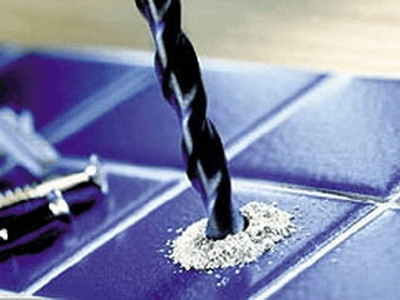
For work with porcelain stoneware surfaces, use diamond tips. The rules for handling them are similar to those described above. You can use a hole saw to drill large holes. But all the same, the technology of creating a small hole works, due to which a large one is drilled. The pilot drill allows you to focus the saw on a single point. If you don’t know which drill to drill tiles with, use the classic spear-shaped ones, with which you can solve the problem.
Tile hole tools
In addition to a drill with a variety of drills, there are many more tools in the repairman's arsenal that will come in handy when working on tiles. Spear-shaped drills (or arrow-shaped ones) stand out among others for their excellent sharpness of the limb. The least load during work and the ability to catch on the center of the hole are practical indicators of the work with these drills. The diamond drill is inferior to the spear drill in terms of reliability and frequency of use. It quickly loses its properties and is erased, which is why it cannot be used to make many holes.
A crown is a tool used to make holes with a large diameter. If you need to drill a hole with a diameter of more than 20 millimeters, be sure to use a crown. You will be able to make a hole with a diameter of up to 150 millimeters.
Ballerina is a special tool equipped with a conventional drill and two cutters, between which you can adjust the distance. The way a ballerina works on a tile cannot be called very convenient; it is easier to make a hole with it on an uninstalled tile. A drill with a ballerina usually vibrates strongly and jumps off, you should first practice on an extra square of tile.
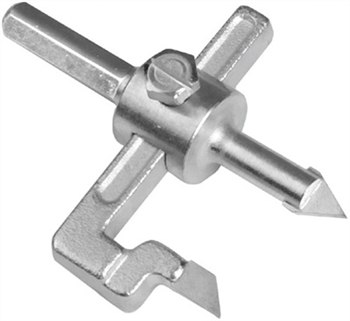
Pro Tips: How to Drill Tile Without Cracking
The most difficult stage in working with tiles is the passage of the upper layer with a drill. It is very easy to scratch and deform, because of this, professionals recommend working with the surface with extreme care. When drilling tiles, the following points should be considered:
- When choosing an electric tool - an electric drill, set the maximum number of drill rotations to no more than 1000 revolutions per minute. You must feel and observe the optimal drilling frequency so as not to spoil the material.
- Don't push on the drill. This can cause tile cracking or scratches that are very difficult to repair.
- Carefully approach the issue of drilling in the seams of the slab: the diameter of the hole should not exceed the width of the seam.
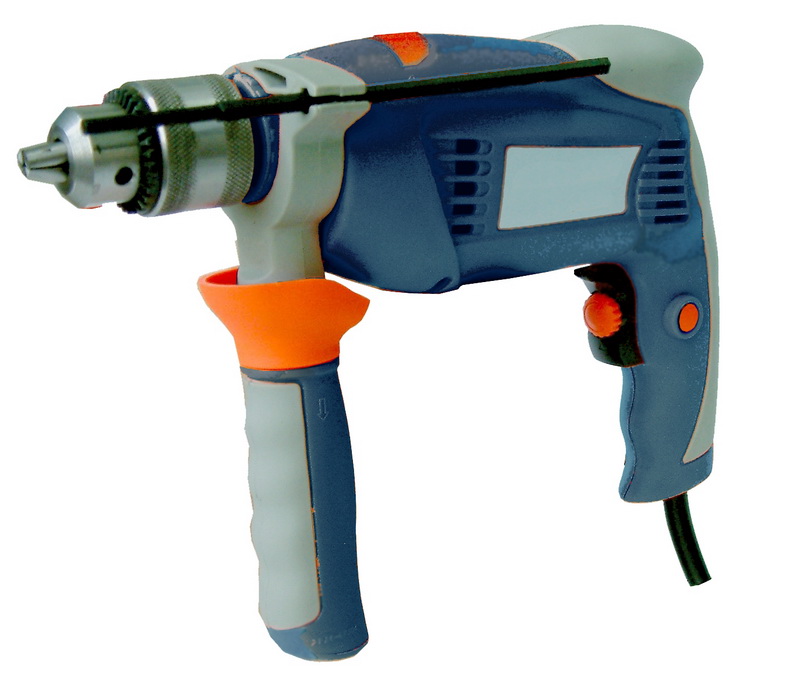
If you did not find a drill and the necessary drills in your arsenal, you can use a simpler and more affordable way. To resolve the drilling issue, make a shallow break on the surface of the tile using the end of the tap. Then install it in the right place and with the help of a hammer gradually deepen. This method is not safe, so try to follow the steps as carefully as possible.
Regardless of the tool you choose to work with tiles, you can not put too much effort. Try to hold the drill, hammer drill or other tool as securely as possible, but do not press on the fragile surface. A crack or even a small scratch is hard to fix and will have to suffer over this problem. To avoid this, don't overdo it. 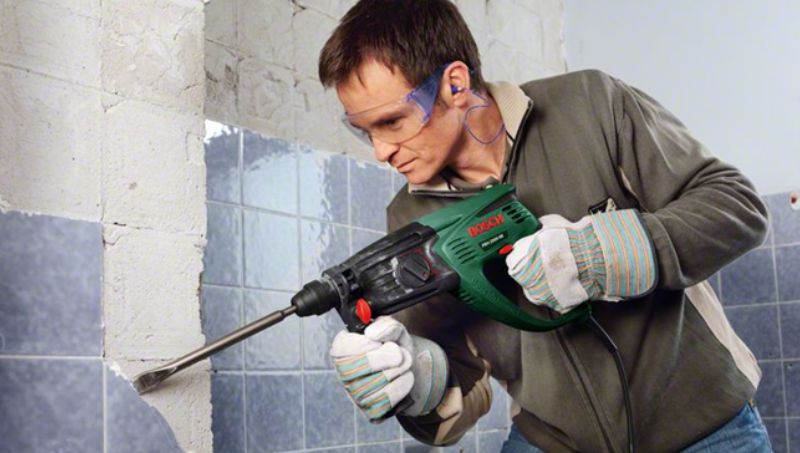
When drilling tiles, the tool is held straight, and the tip is inserted vertically. For the stability of the drill, take care of slip, which can cause cracking. Use the fixing methods that have already been written about above.
You need to work carefully, additionally put on safety glasses. This is necessary to comply with safety rules that prevent shrapnel injuries. If the tile is already glued to the wall and you need to make a hole for the built-in parts, use a drill or puncher.
